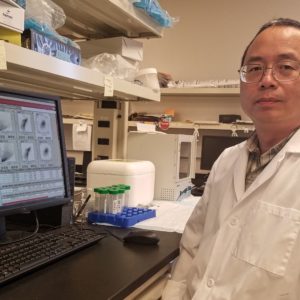Study shows ‘precision nutrition’ may help prevent non-alcoholic fatty liver disease
Texas A&M, Central Texas Veterans Health Care Systems, others collaborate on study
Writer: Paul Schattenberg, 210-859-5752, [email protected]
Contacts: Dr. Chaodong Wu, 979-458-1521, [email protected]
Dr. Gianfranco Alpini, 254-743-1044, [email protected]
COLLEGE STATION – A study led by researchers from the Texas A&M University System and Central Texas Veterans Health Care System, or CTVHCS, shows how a protein known as STING could be a therapeutic target for non-alcoholic fatty liver disease, or NAFLD.
The study, “Expression of STING Is Increased in Liver Tissues from Patients with NAFLD and Promotes Macrophage-mediated Hepatic Inflammation and Fibrosis in Mice,” was recently published online in the journal Gastroenterology. It can found online at https://www.ncbi.nlm.nih.gov/pubmed/30213555.

The study included participation from Baylor Scott and White Health in Temple and the Veterinary Medical Teaching Hospital of Texas A&M University in College Station.
“The study showed nutrition intervention that would target STING to suppress inflammation could be a novel approach for prevention of non-alcoholic fatty liver disease,” said Dr. Chaodong Wu, a Texas A&M AgriLife Research scientist in the nutrition and food science department at Texas A&M in College Station.
Wu said transmembrane protein 173, also called TMEM173 or STING, functions as a major regulator of the innate immune response to viral and bacterial infections by means of macrophage signaling. Macrophages are cells of the immune system that detect, surround and destroy bacteria and other harmful organisms.
“However, if there is nutrition stress, macrophages function differentially from those responding to an infection, contributing to hepatic steatosis, which is an unusual buildup of fat in the liver and non-alcoholic fatty liver disease,” he explained.
Wu said the purpose of the study was to discover if STING would also regulate diet-induced activity in hepatic steatosis, inflammation and liver fibrosis.
“To test this hypothesis, we used mice in which we disrupted the STING gene, mice without disruption of this gene and mice with STING disruption only in myeloid cells,” he explained. “The mice were fed a standard chow diet, a high-fat diet of 60 percent fat calories or a methionine- and choline-deficient, or MCD, diet.”
Study results showed non-parenchymal liver cells – those which interact with hepatocytes and with each other by soluble mediators and direct cell-to-cell contact — from patients with non-alcoholic fatty liver disease had higher levels of STING than liver tissues from patients without the disease.

“STING mice and mice with STING disruption only in myeloid cells developed less severe hepatic steatosis, inflammation and/or fibrosis following a high-fat or MCD diet than control mice,” said Dr. Gianfranco Alpini, distinguished professor in the department of medical physiology at Texas A&M College of Medicine in Temple and research career scientist at the CTVHCS. “Biochemical markers of inflammation were significantly lower in liver tissues from STING mice as compared to control mice after being fed these two types of diet.”
Alpini said transplantation of bone marrow cells from control mice to STING mice further confirmed this response by restoring the severity of steatosis and inflammation following a high fat diet.
“Macrophages from control mice, but not STING-disrupted mice, had increased markers of inflammation in response to the STING activators we used to elicit an inflammatory response,” Alpini said. “Hepatocytes and stellate cells co-cultured with STING macrophages in the presence of the STING agonist DMXAA, or incubated with the medium collected from these macrophages, had decreased fat deposition and markers of inflammation compared to hepatocytes incubated with control macrophages.”
Dr. Shannon Glaser, professor of medical physiology at Texas A&M College of Medicine in Temple and a Veterans Administration investigator, said results showed increased levels of STING in liver tissues from patients with non-alcoholic fatty liver disease and mice with a high fat diet-induced steatosis. In mice, the loss of STING from liver macrophages reduced the severity of fibrosis and the inflammatory response.
“These validate a deleterious role for STING in development and progression of non-alcoholic fatty liver disease,” Glaser said.
Dr. Heather Francis, associate professor of medical physiology at Texas A&M College of Medicine in Temple and a Veterans Administration investigator, stressed the importance of the study’s finding that STING stimulation also directly increases the activation status of hepatic stellate cells.
“This implicates a detrimental role for STING in liver fibrosis and indicates targeting STING using either small molecules or specific microRNAs may lead to important patient therapies,” Francis said.
Alpini said study findings will help improve understanding of the disease pathophysiology.
“More importantly, this study has validated the feasibility of STING as a target for management of the disease,” he said.
Wu said the study is an example of how “precision nutrition” as advocated by Dr. Patrick Stover, vice chancellor and dean of agriculture and life sciences at Texas A&M, can be effective in the treatment of disease.
This work was supported by the resources of CTVHCS, Texas A&M University and AgriLife Research.


